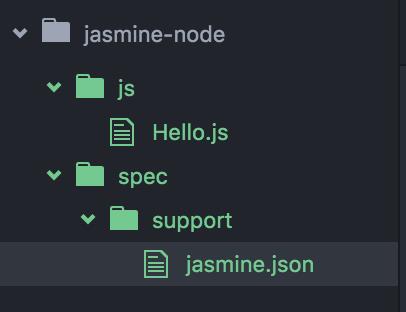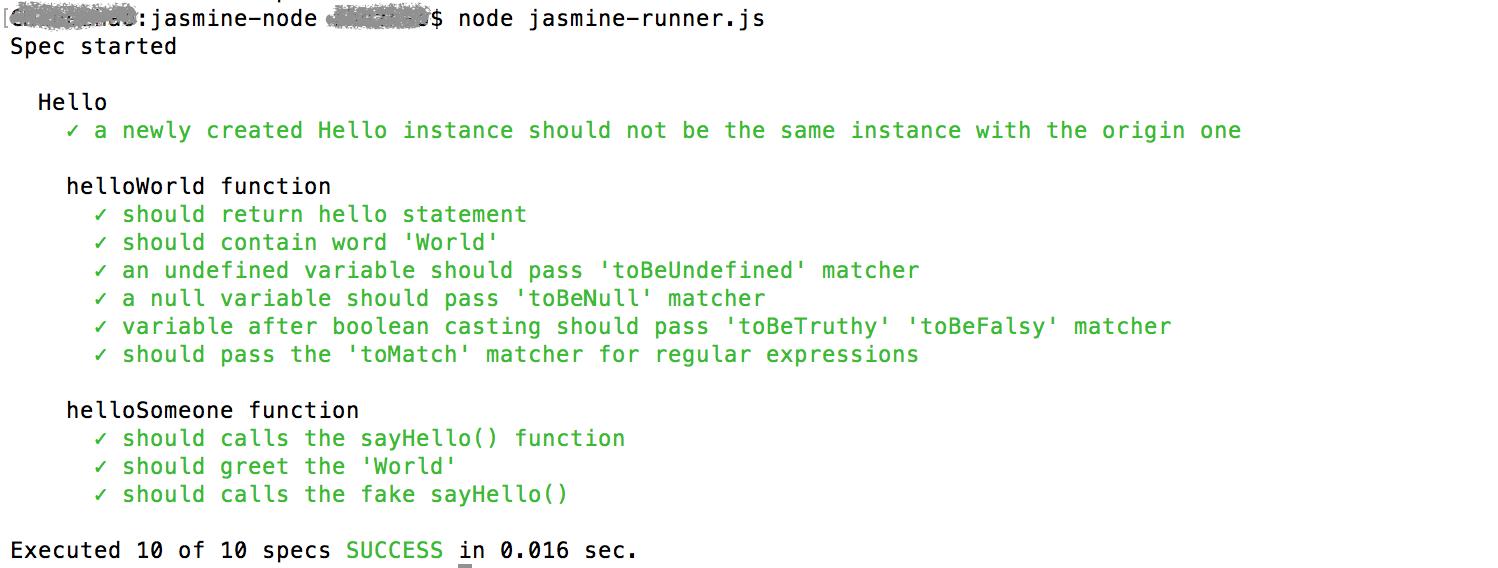使用 Jasmine 测试 Node 项目
Posted
tags:
篇首语:本文由小常识网(cha138.com)小编为大家整理,主要介绍了使用 Jasmine 测试 Node 项目相关的知识,希望对你有一定的参考价值。
在上一篇文章(Jasmine Introdunction)中,我们已经介绍了如何在浏览器中运行 Jasmine 测试框架。对于浏览器端的 JS 代码来说,这无疑是很方便的。那么 Jasmine 能否用来对服务端的代码进行测试呢?答案当然是可以。本文中,我们就将介绍如何在基于 Node 的项目中,方便快捷地运行 Jasmine 测试。
同上篇文章一样,我们依旧新建一个待测试的 JS 文件 js/Hello.js

function Hello() {}; Hello.prototype.foo = "foo"; Hello.prototype.bar = null ; Hello.prototype.helloWorld = function() { return "Hello World!"; } Hello.prototype.helloSomeone = function(toGreet) { return this.sayHello() + " " + toGreet; } Hello.prototype.sayHello = function() { return "Hello"; } module.exports = Hello;
安装 Jasmine Module
首先,使用 npm 全局安装 jasmine 模块:
npm install -g jasmine
进行全局安装后,我们就可以直接在终端执行 jasmine 命令了。执行:
jasmine -v
就可以看到当前安装的 jasmine 版本。这里我安装的版本为 jasmine v2.4.1。
初始化
接下来,我们就需要对测试项目进行初始化了。我们可以手动进行初始化,但更简单的方式是直接在项目目录下运行命令:
jasmine init

jasmine 会在当前目录下生成一个配置文件 spec/support/jasmine.json
{ "spec_dir": "spec", "spec_files": [ "**/*[sS]pec.js" ], "helpers": [ "helpers/**/*.js" ], "stopSpecOnExpectationFailure": false, "random": false }
其中 spec_dir: 指定扫描测试文件的根目录
spec_files: 匹配测试文件的表达式
helpers: Helper 文件会在所有的 spec 之前预先执行
stopSpecOnExpectationFailure: 当有错误出现时是否终止所有测试
random: 是否打乱测试顺序
添加测试代码
接下来,就该添加我们的测试代码了。分别添加 spec/Hello.spec.js

describe("Hello", function () {
var Hello = require("../js/Hello");
var hello;
beforeEach(function () {
hello = new Hello();
});
it("a newly created Hello instance should not be the same instance with the origin one", function () {
expect(hello).not.toBe(new Hello());
expect(hello).toEqual(new Hello());
});
describe("helloWorld function", function () {
it("should return hello statement", function () {
expect(hello.helloWorld()).toBe("Hello World!");
});
it("should contain word ‘World‘", function () {
expect(hello.helloWorld()).toContainWord("World!");
});
it("an undefined variable should pass ‘toBeUndefined‘ matcher", function () {
expect(hello.a).toBeUndefined();
});
it("a null variable should pass ‘toBeNull‘ matcher", function () {
expect(hello.bar).toBeNull();
});
it("variable after boolean casting should pass ‘toBeTruthy‘ ‘toBeFalsy‘ matcher", function () {
expect(hello.foo).toBeTruthy();
expect(hello.bar).toBeFalsy();
});
it("should pass the ‘toMatch‘ matcher for regular expressions", function (){
expect(hello.helloWorld()).toMatch(/^\\w*\\s\\w*!$/);
});
});
describe("helloSomeone function", function () {
it("should calls the sayHello() function", function () {
spyOn(hello, "sayHello");
hello.helloSomeone("Chou");
expect(hello.sayHello).toHaveBeenCalled();
expect(hello.sayHello).toHaveBeenCalledTimes(1);
});
it("should greet the ‘World‘", function () {
spyOn(hello, "helloSomeone");
hello.helloSomeone("World");
expect(hello.helloSomeone).toHaveBeenCalledWith("World");
expect(hello.helloSomeone).not.toHaveBeenCalledWith("world");
});
it("should calls the fake sayHello()", function () {
hello.sayHello = jasmine.createSpy("‘sayHello‘ spy");
hello.helloSomeone("world");
expect(hello.sayHello).toHaveBeenCalled();
});
});
});
spec/helpers/SpecHelper.js

beforeEach(function () { jasmine.addMatchers({ toContainWord: function () { return { compare: function (actual, expected) { var result = {}; result.pass = (actual.indexOf(expected) !== -1); if( result.pass ) { result.message = "Expected " + actual + " to contain " + expected + "."; } else { result.message = "Expected " + actual + " to contain " + expected + ", but it does not."; } return result; } } } }); });
(若对测试代码有疑问,请移步 Jasmine Introdunction)
运行测试
当我们添加了测试代码,并且配置好了配置文件 jasmine.json ,就可以回到根目录下,直接执行命令:
jasmine

就可以看到我们的 10 个测试用例全部顺利通过了。不过每个通过的测试,只是由一个绿色的点表示。很多时候,我们都希望能够看到全部的测试用例,以及不同测试用例之间的层级关系,仅是一个绿色的小点并不利于我们进行调试。这里我们再介绍一个模块: jasmine-spec-reporter 能够很好地解决这个问题。
首先,执行如下命令在本地安装 jasmine 和 jasmine-spec-reporter
npm install jasmine --save-dev npm install jasmine-spec-reporter --save-dev
然后在项目根目录,添加 jasmine-runner.js

var Jasmine = require(‘jasmine‘); var SpecReporter = require(‘jasmine-spec-reporter‘); var noop = function() {}; var jrunner = new Jasmine(); jrunner.configureDefaultReporter({print: noop}); // remove default reporter logs jasmine.getEnv().addReporter(new SpecReporter()); // add jasmine-spec-reporter jrunner.loadConfigFile(); // load jasmine.json configuration jrunner.execute();
这段代码展示了在没有全局安装 jasmine 时,如何通过调用 library 来使用 jasmine 测试框架测试我们的代码。
运行命令:
node jasmine-runner.js

现在的输出是否更清晰明了了呢~
到目前为止,我们已经介绍了如何使用 Jasmine 测试框架来对 Node 项目进行测试。希望本文能对你有所帮助。如果你觉得本文有任何问题,还望不吝赐教。
以上是关于使用 Jasmine 测试 Node 项目的主要内容,如果未能解决你的问题,请参考以下文章
